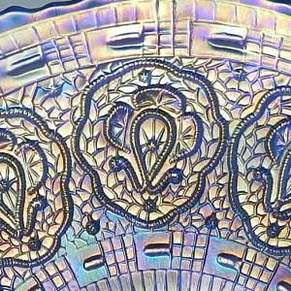Carnival Patterns inspired by Embroidery and Needlecraft - Part Two
Here, in Part Two, we look at some of the Carnival patterns that were inspired by needlecraft and embroidery.
Firstly, let's put a name to some of the stitches.
Here, in Part Two, we look at some of the Carnival patterns that were inspired by needlecraft and embroidery.
Firstly, let's put a name to some of the stitches.
Left to right: satin stitch, blanket stitch, buttonhole bars, basket filling stitch, needle lace, and serpentine hem stitch.
Many of these stitches may immediately trigger a connection with well known Carnival Glass patterns, and some may be a little more difficult to recognise. What is clear is that a wide range of stitches were used by the mould makers, either as the main pattern motif, or as a “filler”, intended to pick up and reflect iridescence in what would otherwise be blank spaces in the pattern. The shimmering colours and light-catching qualities of Carnival Glass’s iridescence produce a magnificent effect.
Captive Rose, Fenton
In this highly stylised floral pattern, the Captive Rose design is clearly imitative of needlecraft, in particular the portrayal of the rose looks like a representation of embroidered satin stitch, while the encircling hexagons are portrayed as if in blanket stitch. Indeed, the whole pattern gives the impression of having been delicately stitched by hand! Quite an achievement. It’s an intricate, highly complex design that takes iridescence very well indeed.
Captive Rose appears in Butler Brothers catalogues from Spring 1911. Did Frank Fenton watch his wife, Lilian, stitching this design, and then capture it in glass in “Captive Rose”?
|
On the left is a detailed image of the Captive Rose pattern, and several elements are immediately recognisable as needlework.
The rose itself is satin stitch, blanket stitch is used around the hexagons that connect the roses, as well as buttonhole bars and the needle lace "filler" pattern. Above left is how the rose design looks like embroidered in silks. |
Persian Medallion, Fenton
Persian Medallion was clearly a very popular design, as it appears in Butler Brothers ads from 1911 through to 1924 (and it was a pattern that Fenton subsequently reissued in contemporary Carnival Glass).
Persian Medallion was clearly a very popular design, as it appears in Butler Brothers ads from 1911 through to 1924 (and it was a pattern that Fenton subsequently reissued in contemporary Carnival Glass).
|
Its intricate and detailed design is clearly imitative of needlecraft: the “medallions” in the pattern look like satin stitch. There is also a motif that was used regularly by Fenton as a background “filler” - it has previously been though to represent overlapping scales, but an authority on needlecraft has informed us that the “scale filler” is in fact a perfect rendering of needle lace.
The same pattern can be seen on many other Fenton patterns, like Fentonia, Orange Tree, Leaf Chain and Cherry Chain. |
Hearts and Flowers, Northwood
|
This is another design that imitates embroidery stitches. Again, it is essentially a highly stylised floral design, and Hearts and Flowers also takes iridescence very well.
It is a complex and beautifully composed design made up of repeated motifs. The “hearts” appear as though they were crafted in satin stitch, and there are also elements of blanket stitch and needle lace. The pattern first appeared in the shape of a bowl and a comport in Butler Brothers catalogue ads of 1912. |
|
Hattie, Imperial
At first glance, Hattie owes more to geometry than embroidery. It is an intricate and complex design that certainly seems to have been drawn up using mathematical instruments. But look more closely and you will see that the buttonhole bars motif that is repeated all over the design is in fact imitative of embroidery stitchwork. |
|
Embroidered Mums, Northwood
Embroidered Mums was named for its obvious inspiration: the flowers are picked out in satin stitch, and a perfect representation of serpentine hem stitch can be seen on either side of the "greek key" border that encircles the pattern. Was Clara Northwood working on her needlework when Harry thought it would be perfect for a new design in Carnival Glass? |
|
Dragon and Lotus, Fenton - spot the similarity! The image below is from a book, "Embroidery" by Grace Christie, 1909, which goes into great detail about which stitches should be used to create the embroidery. Fenton's mould makers translated it into Carnival Glass to spectacular effect in the centre of Dragon and Lotus. .
|
Big Basketweave, Dugan - a perfect match to basket filling stitch Fentonia, Fenton - motifs of buttonhole bars and needle lace abound! |
In Part Three, we show some of Glen's amazing drawings of some of the popular Carnival Glass patterns that were inspired by needlecraft. The drawings show in fine detail, the skills of the Carnival Glass designers and mould makers.
Back to Part One
Back to Part One

















